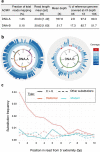Contribution of historical herbarium small RNAs to the reconstruction of a cassava mosaic geminivirus evolutionary history
- PMID: 34711837
- PMCID: PMC8553777
- DOI: 10.1038/s41598-021-00518-w
Contribution of historical herbarium small RNAs to the reconstruction of a cassava mosaic geminivirus evolutionary history
Abstract
Emerging viral diseases of plants are recognised as a growing threat to global food security. However, little is known about the evolutionary processes and ecological factors underlying the emergence and success of viruses that have caused past epidemics. With technological advances in the field of ancient genomics, it is now possible to sequence historical genomes to provide a better understanding of viral plant disease emergence and pathogen evolutionary history. In this context, herbarium specimens represent a valuable source of dated and preserved material. We report here the first historical genome of a crop pathogen DNA virus, a 90-year-old African cassava mosaic virus (ACMV), reconstructed from small RNA sequences bearing hallmarks of small interfering RNAs. Relative to tip-calibrated dating inferences using only modern data, those performed with the historical genome yielded both molecular evolution rate estimates that were significantly lower, and lineage divergence times that were significantly older. Crucially, divergence times estimated without the historical genome appeared in discordance with both historical disease reports and the existence of the historical genome itself. In conclusion, our study reports an updated time-frame for the history and evolution of ACMV and illustrates how the study of crop viral diseases could benefit from natural history collections.
© 2021. The Author(s).
Conflict of interest statement
The authors declare no competing interests.
Figures





References
-
- Savary S, Ficke A, Aubertot JN, Hollier C. Crop losses due to diseases and their implications for global food production losses and food security. Food Secur. 2012 doi: 10.1007/s12571-012-0200-5. - DOI
Publication types
MeSH terms
Substances
Supplementary concepts
LinkOut - more resources
Full Text Sources
Miscellaneous

